|
Mk1
(left) versus Mk2 (right)
History
Conventional
car makers produce conventional cars. Revolutionary ideas usually come
from outsiders. Smart is a good example. The idea of "smart car" was
originated by Swatch, the Swiss fashion watch maker, in the early
1990s. Swatch saw that nowadays more and more people live in big
cities. Our urban roads get increasingly congested, making fast and
powerful cars useless. Big cars are difficult to find parking spaces.
Moreover, most people only need to travel to work or shopping in short
distances and they rarely need to take more than 2 people on board. So
why do we need to drive a 4.5-meter long, 1.5-ton 5-seater everyday,
drinking excessive fuel, generating excessive pollution and eventually
find no space to park ? Swatch came up the idea of "smart car", a tiny
city car measuring only 2.5 meters long, weighing 700 kilograms and
seating strictly 2 people. It fulfills the needs of the 21st Century
and sounds every bit politically correct. But more than that, Swatch
succeeded to make the car looks tasteful and fashionable. Its monospace
design looked funky and highly desirable. It had a two-tone color
scheme made possible by painting the plastic body panels and the
exposed steel chassis frame in different colors. You can order very
fancy artistic graphics as well. When you get bored of the colors, you
can have the clothes replaced easily at dealer shops, again an idea
came from the fashion watches of Swatch.
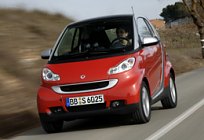 However,
Swatch did not have the money and engineering / manufacturing expertise
to realize the project. It found a partner called Daimler-Benz. At the
time, the German giant was highly interested in expanding its business
to small cars – not even the addition of A-class could satisfy it. It
invested heavily into the Smart project and took 51 percent stakes in
the joint-venture. This eventually raised to 100% as additional
investment was found necessary to re-engineer the car and Swatch
decided to withdraw. Since then Smart became a division of
Daimler-Benz. However,
Swatch did not have the money and engineering / manufacturing expertise
to realize the project. It found a partner called Daimler-Benz. At the
time, the German giant was highly interested in expanding its business
to small cars – not even the addition of A-class could satisfy it. It
invested heavily into the Smart project and took 51 percent stakes in
the joint-venture. This eventually raised to 100% as additional
investment was found necessary to re-engineer the car and Swatch
decided to withdraw. Since then Smart became a division of
Daimler-Benz.
The
rest is history. Although 770,000 units were sold in 8 years, Smart has
never turned a profit for its mother company. DaimlerChrysler once
tried to broaden its appeal by introducing Forfour and Roadster, but
that only worsened the loss. In the end, the two newcomers were axed
and Smart returned to its root as a 2-seater city car.
I always admire the idea of Smart very much. Even until today I still
persist that the idea could work. So why did it fail ? very
unfortunately, it got a wrong mother. The biggest weakness of Smart is
the fact that it was seriously overpriced. It was overpriced because it
could not share any parts with the luxurious cars of Mercedes-Benz. Put
simply, Smart and Mercedes are two different worlds and they should not
intersect. If it were purchased by Volkswagen or Fiat, it would have
had a lower cost structure and would have probably succeeded already.
New Fortwo
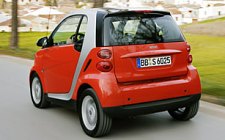 Dr. Zetsche, DaimlerChrysler's
CEO, should know this too. When he decided to keep the division alive,
he requested his men to redesign the car to lower production costs. The
Mk2 Fortwo employs a new dashboard which is cheaper to build. It
discarded the rear quarter windows and reduced the number of taillights
from 6 to 4. It also replaced the in-house-built 600cc turbocharged
3-cylinder engine with a mass production, 999cc unit outsourced from
Mitsubishi. It is cheaper to buy yet gives the new car better highway
performance. The engine has 4 states of tune: 61hp and 71hp naturally
aspirated, 84hp and 98hp (Brabus) turbocharged, all running twin-cam
and 4 valves per cylinder. Dr. Zetsche, DaimlerChrysler's
CEO, should know this too. When he decided to keep the division alive,
he requested his men to redesign the car to lower production costs. The
Mk2 Fortwo employs a new dashboard which is cheaper to build. It
discarded the rear quarter windows and reduced the number of taillights
from 6 to 4. It also replaced the in-house-built 600cc turbocharged
3-cylinder engine with a mass production, 999cc unit outsourced from
Mitsubishi. It is cheaper to buy yet gives the new car better highway
performance. The engine has 4 states of tune: 61hp and 71hp naturally
aspirated, 84hp and 98hp (Brabus) turbocharged, all running twin-cam
and 4 valves per cylinder.
Another
way to improve profitability is to sell more cars.
DaimlerChrysler wants Fortwo to appeal to more customers by improving
practicality and by selling it in the North America. Some 55 mm and 40
mm are added to the wheelbase and width respectively to enlarge the
cabin. Another 140 mm is added to the front and rear overhangs to pass
newer EU and Federal crash protection regulations. The longer rear
overhang also frees up boot volume from 150 to 220 liters. This is a
practical little car for everyday use – as long as you need only two
seats.
The basic architecture of the car remains unchanged. In other words,
the engine is mounted at the rear axle and under the luggage space,
driving the rear wheels via a clutchless manual gearbox with auto mode.
However, the outgoing motorcycle-derived 6-speed gearbox was criticized
for slow and jerky shift, thus it is replaced by a new 5-speed unit
from Getrag. The suspensions continue to be MacPherson struts up front
and de-Dion axle at the rear. However, a 30mm increase of tracks should
improve cornering.
Exterior and Interior
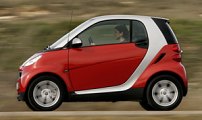 Design
has always been the trump card of Smart. Most people are willing to pay
premium for the little car simply because they love its design so much.
Driving a Smart is a statement of taste, personality and environmental
consciousness. Small car, big meaning. Design
has always been the trump card of Smart. Most people are willing to pay
premium for the little car simply because they love its design so much.
Driving a Smart is a statement of taste, personality and environmental
consciousness. Small car, big meaning.
The Mk2 Fortwo keeps much of such character, but quite sadly, it does
not look as pretty as the old car. The extra space added to the front
and rear hampers somewhat the integrity of the original monospace
design. A faster hatchback in addition to the loss of rear quarter
windows also degraded the visual impact a bit. The accumulated effect
is not big enough to wipe out the Smart from enthusiasts' wish list,
but we can't help feeling sorry that the new generation of designers at
DaimlerChrysler fail to match those of the previous Swatch or Michael
Mauer, the designer of Smart Roadster. The most beautiful parts of the
new Fortwo are wherever it didn't alter. Wherever it altered, it became
only uglier.
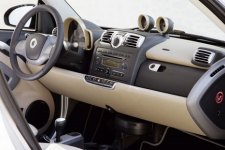 Open
the doors, fans of the previous Smart must be shocked: the funky
rotating center console has been replaced by a conventional-looking
dashboard. The official explanation is to meet the US safety
regulations, but to me the driving force seems to be lower cost. On the
positive side, the new dash offers more storage spaces and the material
quality seems slightly better. The cabin provides slightly more room
for two. The passenger seat is still offset rearward to free up
shoulder room. Seat comfort and driving position are superb. Open
the doors, fans of the previous Smart must be shocked: the funky
rotating center console has been replaced by a conventional-looking
dashboard. The official explanation is to meet the US safety
regulations, but to me the driving force seems to be lower cost. On the
positive side, the new dash offers more storage spaces and the material
quality seems slightly better. The cabin provides slightly more room
for two. The passenger seat is still offset rearward to free up
shoulder room. Seat comfort and driving position are superb.
Believe or not, the little Smart can swallow more luggage than a Mini
or a Toyota Aygo – and by a considerable margin. There is 220 liters of
space at the boot, or 340 liters if you store the luggage up to the
roof. This should be more than enough for most usage. Some people may
argue that its conventional rivals can easily find more luggage space
once folded the rear seat. But those understanding the philosophy of
the Smart city car will never ask such silly questions.
On the Road
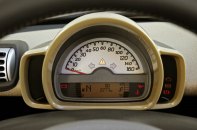 The old Fortwo never performed
well in dynamic aspect. It is easy to
understand why: its small engine and slow gearchange limited its
performance. Its ultra-short wheelbase and non-independent de-Dion
suspension were inherent disadvantages to ride quality. Its tall body
and narrow track width seriously limited its handling. To prevent from
rollover, engineers had to build heavy understeer into the chassis and
set the steering very slow, so the car never felt as nimble as its tiny
size suggested. The old Fortwo never performed
well in dynamic aspect. It is easy to
understand why: its small engine and slow gearchange limited its
performance. Its ultra-short wheelbase and non-independent de-Dion
suspension were inherent disadvantages to ride quality. Its tall body
and narrow track width seriously limited its handling. To prevent from
rollover, engineers had to build heavy understeer into the chassis and
set the steering very slow, so the car never felt as nimble as its tiny
size suggested.
The
new
Fortwo is still purely a city car, but it is greatly improved in
dynamic aspect. Its larger engines, no matter normally aspirated or
turbocharged, can easily propel the 750 kg car to the regulated top
speed of 90 mph. Its new gearbox shifts noticeably faster and smoother.
Its longer wheelbase, wider track and modified suspension improved
cornering and high-speed stability. The car is now more at home on
highway, being less influenced by crosswinds or the vacuum effect from
trucks running beside. In corners, the quicker steering rack feels more
direct and the car understeers less – yes, it still understeers
moderately. The ride is still hard over broken surfaces but not as
harsh as the old car.
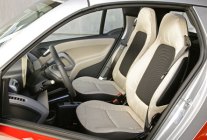 Everything is relative. Despite
of the improvements, you still can't
compare this car with a conventional mini car. For the same – or less -
money, you can buy a conventional car with higher performance, better
handling and ride and a couple of rear seats. They won't charge you so
much for extra features too. But as the fans of Smart always know, what
counts here is not objective measurement, but the fact that no other
cars look and drive the same way as Smart. This hasn't changed much in
the making of Mk2 – despite of that slight degrade in style. The only
change is that it has far less weaknesses to put up with. Everything is relative. Despite
of the improvements, you still can't
compare this car with a conventional mini car. For the same – or less -
money, you can buy a conventional car with higher performance, better
handling and ride and a couple of rear seats. They won't charge you so
much for extra features too. But as the fans of Smart always know, what
counts here is not objective measurement, but the fact that no other
cars look and drive the same way as Smart. This hasn't changed much in
the making of Mk2 – despite of that slight degrade in style. The only
change is that it has far less weaknesses to put up with.
Undoubtedly, Smart will continue to split opinions. Some people will
find it a silly deal while some people will be mad about its design and
concept. As AutoZine always promote the diversification of cars and
environmental consciousness, we welcome the arrival of Mk2 and hope it
will finally make a profit for DaimlerChrysler. |